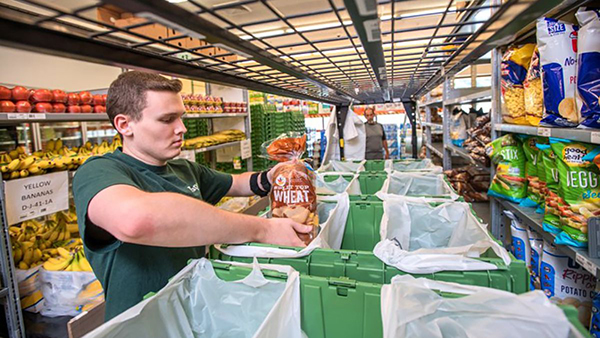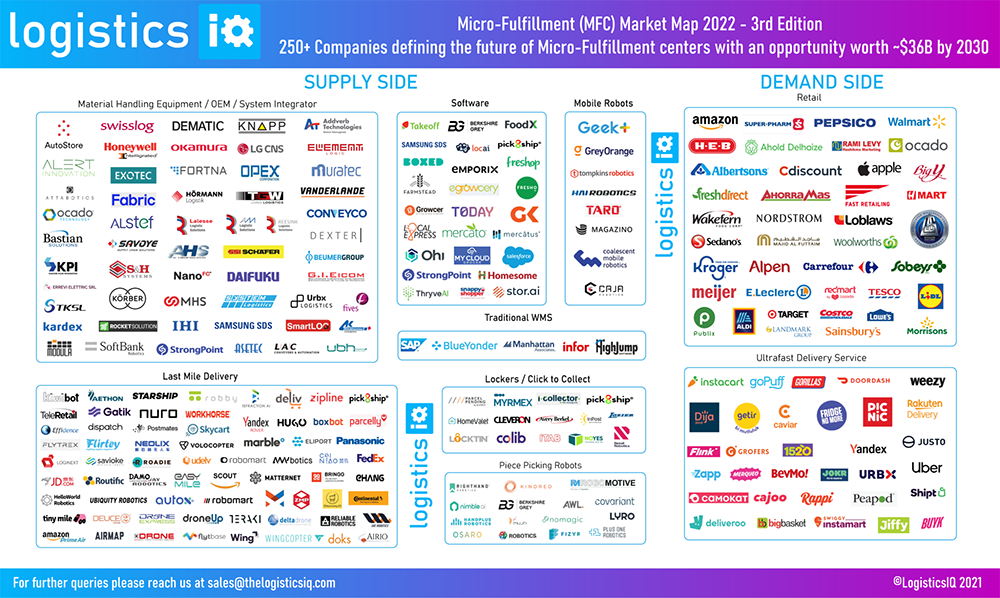It is expected that there will be one micro-fulfillment center for every 10th of U.S. total 40000 grocery stores by 2030.”
CLOSELY-WATCHED TRENDS
Micro Fulfillment Centers (MFCs), a highly recommended popular e-commerce strategy, is an effective way to meet the rising volumes, the changing geographical nature of e-commerce demand, and the growing desire for same-day delivery.
Micro Fulfillment Market has been the most important and emerging trend during pandemic (COVID-19) coming out from some bigger trends like eGrocery Growth, Urban Warehouses and Automated Cold Storages. Huge investment in start-ups like Takeoff Technologies ($86M+), Fabric ($136M+), Attabotics ($82M+), Exotec Solutions ($111M+) and Alert Innovation are witnessing this growth along with presence of existing traditional players like Dematic, Swisslog, Knapp, OPEX Corporation, Muratec, AutoStore, Honeywell Intelligrated and Vanderlande. Retailers such as Walmart, Amazon, Kroger, Woolworths, Amazon, Ocado, Carrefour, Uniqlo, Meijer, H-E-B, Albertsons, Majid Al Futtaim and Ahold Delhaize have already started adopting and implementing these new technologies during pandemic.
Apart this, piece picking robots suppliers like Berkshire Grey, Righthand Robotics, Kindred AI, Covariant, OSARO, Plus One Robotics, XYZ Robotics, Fizyr have established a new attractive capability for order picking in ecommerce fulfillment to transfer the good-to-person (G2P) systems into good-to-robot (G2R) systems.
As per this market study, Micro Fulfillment Market is expected to grow with a CAGR of ~60% between 2020 and 2026 with a maximum market share from U.S. Recently developments have been started in Europe and APAC as well for countries like U.K., France, Japan and Australia. Even there are some order intake in UAE, Saudi Arabia and Israel from middle east region as well. Grocery is going to be the main contributor for this market with 70%-80% market share although general merchandise and other industries are also going to adopt the market very soon.
~$10B in next 6 years with an installed base of ~2000 MFCs
- Micro Fulfillment Centers (MFCs)…
a highly recommended popular e-commerce strategy, is an effective way to meet the rising volumes, the changing geographical nature of e-commerce demand, and the growing desire for same-day delivery. As per LogisticsIQ’s latest market research study,
Micro Fulfillment Market is expected to have a cumulative opportunity worth ~$10B in next 6 years by 2026 with an installed base of ~2000 MFCs if the technology and concept remain permanent. Year 2023 is going to be the cornerstone for Micro Fulfillment market touching a billion-dollar mark and setting the base for the future. It is expected that there will be one micro fulfillment center for every 10th of U.S. total 40000 grocery stores by 2030.
This post-pandemic market study is having a market analysis of more than 75 players (part of our exclusive Market Map), Key Technologies, Targeted Warehouse Sizes and 20 geographic regions although this market is getting adopted mainly in U.S. at present. Analysis is validated through 50+ in-depth interviews across the value chain with components and technology providers, system integrators & manufacturers, grocery stores and end-user industry verticals.
Market size tables are also available in an excel format to analyse further. It is a best reference to analyse the market attractiveness, to identify the partner, customer or supplier, to check the competitive landscape, to benchmark the new technologies and to select the right geography & industry vertical for your products and services. Voice and opinion of grocery stores have been taken as the key parameter for this market forecast. As per the study, Micro Fulfillment Market will reach to 10X mark by 2025 as compared to current market size.
Micro Fulfillment – need of the hour
Industry giants such as Amazon, Walmart, Ocado, Kroger and Alibaba are driving the “best-in-class” e-commerce fulfillment strategy for the last decade. They are also investing in cutting-edge robotics and automation for their Customer Fulfillment Centers (CFCs) – that are continuously redefining target productivity and service levels.
But these centralized fulfillment centers are situated far away from the city and have an additional transportation cost along with considerably more delivery time as compared to consumer’s expectations, especially in grocery and F&B industry. Online grocery is already having a slim profit margin and micro-fulfillment has the ability to increase its margin and to make e-commerce accessible to a broader range of retailers because it cuts down major costs like
- The cost of storage, retrieval and picking (through automated MFC)
- The cost of the last mile delivery (through hyperlocal placement).
- The cost of real estate (through condensing fulfillment centers down into MFCs).


That’s why, Micro Fulfillment Center (MFC) is a perfect solution for urban warehouses with an approximated size between 5000 SF and 25000 SF that can meet the requirement of same day delivery through in-store picking or multiple last-mile delivery options. It can even be deployed at backside of the retail store, malls or basements. A typical MFC system is having 1-2 aisles Dry + 1-2 aisles Chilled, 5,000-8,000 totes 10-high storage to 24’ x 2-deep, 2 decanting stations and 2-4 pick stations with each station picking at 700-800 UPH.
Top Factors
- It is estimated that online grocery will contribute more than 10% of overall grocery sale in US by 2025.
- It is expected that consumers will continue with habit of buying online grocery developed during pandemic.
- Delivery option may vary as Home Delivery, In-Store Pick Up, Curb side Pickup, Locker Delivery etc.
- Urban warehouses with automation will be key to meet this demand with same day delivery expectations.
- Delivery Fee is the one of the key factors to decide the digital channel.
- Key to make online grocery business more profitable as compared to current scenario of either net loss or thin profit margin
Micro Fulfillment Advantages vs Customer Fulfillment Center (CFC)
- Low CapEx and TCO; Even OpEx model works quite well like pay per pick or RaaS
- Lesser time to build and install (4-8 weeks)
- Eliminates the requirement of Conveyors
- Faster delivery for end-customer (same day delivery)
- Low cost for labor (automated fulfillment) and better last mile delivery (closer to end-customer)
- Home Delivery and In-Store Shopping, both options are open through In-store Fulfillment
- Direct relationship between retailer and customer. No or minimum 3rd party involvement for this customer experience


